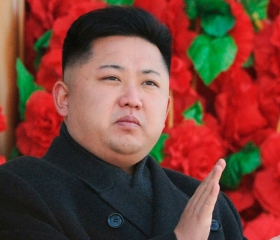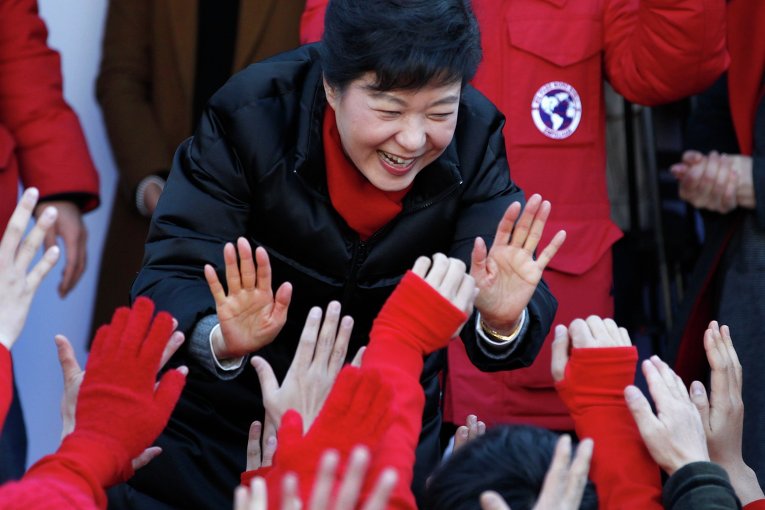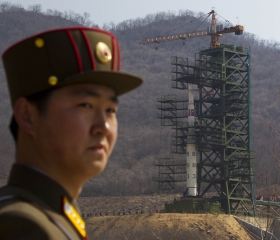Inter-Korean Dialogue and Reconciliation Prospects
(no votes) |
(0 votes) |
Doctor of Economics, Professor of Oriental Studies, Director of the Asian strategy center at the Institute of Economics of the Russian Academy of Sciences
The development of inter-Korean relations follows a sine curve: a crisis gives way to détente which, in turn, is replaced by strained relations. At the moment, we might expect a relaxation in the level of confrontation and the parties’ transition to dialogue (perhaps, one of the goals of Pyongyang’s military hysteria in early 2013 was exactly an attempt to resume the dialogue from a position of strength).
The development of inter-Korean relations follows a sine curve: a crisis gives way to détente which, in turn, is replaced by strained relations. At the moment, we might expect a relaxation in the level of confrontation and the parties’ transition to dialogue (perhaps, one of the goals of Pyongyang’s military hysteria in early 2013 was exactly an attempt to resume the dialogue from a position of strength). Russia has the ability to tactfully deal with both Korean states, encouraging peaceful non-confrontational approaches to solving existing problems, at the same time consolidating its role as an active actor in the negotiation process on the Korean settlement.
Eternal confrontation?
For decades, inter-Korean relations have resembled a pendulum. They have swung from cautious bilateral probing and talk about reducing tensions and even practical cooperation to crises and mutual recriminations, sometimes turning into armed clashes. The party usually responsible for the choice between cooperation and fighting appears to be the North. However, changes in Seoul’s approaches to North Korea have been notable, called forth by the change of administration or foreign policy considerations that are triggering these turns in the policy of the North.

Richard Weitz: Pyongyang’s Mood Swings
However, the essence of inter-Korean relations remains unchanged. The Korean War is not yet over, as both sides believe that only complete victory over the enemy and its capitulation can put it to end.
When the socialist world existed, the North hoped it would still be able to finish the job started in 1950 and capture the South, even if the two global systems had to come into conflict. Since the 1990s, Pyongyang has given up such ambitions, as plunging into any adventure of the kind would inevitably result in the utter defeat of the North. Increased pressure from the international community has made self-preservation the priority task of the regime’s elite.
In contrast, after the global collapse of the socialist system, a significant number of conservative politicians in the South came to believe that the collapse of the North Korean regime and the unification on terms of the South was not far off. Although Seoul does understand that an avalanche of unification will not only incur inevitable casualties among the North Korean elite, but will also cause problems for South Korea, which the latter will be unable to cope with. Even if reunification takes place relatively peacefully and centers of resistance are rapidly suppressed, a unified Korea risks a loss of global competitiveness, since hundreds of billions of dollars will have to be funneled towards modernizing the ruined North Korean economy, laying a heavy burden on the South Korean economy. A more likely scenario of a protracted conflict involving resistance movements (the number of “guerillas” composed of military and intelligence personnel who have nothing to lose may reach tens of thousand people) will severely damage the Korean and regional economies and send Korea backward, assigning it a second-rate role in regional and global affairs for a long time.
The essence of inter-Korean relations remains unchanged. The Korean War is not yet over, as both sides believe that only complete victory over the enemy and its capitulation can put it to end.
At the same time both Koreas share ideas of nationalism and want to solve their problems without outside interference. In May 1972 during the very first meeting after the war between the North and the South, Seoul’s representative Lee Hu-rak started with a statement that President Park Chung-hee disliked foreign interference most of all, and Kim Il Sung echoed that they had to exclude interference of external forces ... and unite on a national basis. [See: Don Oberdofer. The Two Koreas. A Contemporary History. London, Warner Books, 1999, p.23]
What can we expect in the foreseeable future? After the collapse of world socialism, the DPRK remained without Soviet nuclear umbrella and without the help of fraternal countries, which changed its position in the global system of international relations dramatically and jeopardized its very existence.
Since then, inter-Korean relations have undergone three stages. The “Zero Phase,” when North Korea attempted to achieve rapprochement with the South by concluding agreements on reconciliation and denuclearization in 1991-1992, ended pretty quickly. The reason was simple – the United States exerted pressure on North Korea in connection with the latter’s nuclear program with the view of the rapid elimination of the regime as had happened with other socialist countries.
In the 1990s, Kim Young-sam’s administration believed in the imminent collapse of North Korea, which explains its hawkish hard-line position toward Pyongyang. Seoul insisted on denuclearization, reforms and openness, which in fact was tantamount to surrender by the North. North Koreans were especially outraged by the reaction of southerners to the death of Kim Il-sung in 1994. Instead of condolences, South Korea declared a state of emergency in anticipation of the collapse of the North Korean regime and displayed open hostility to the new regime of Kim Jong Il. The opportunity for improving inter-Korean relations on the basis of Korean nationalism under the new historical conditions, i.e. the termination of bipolar confrontation, previously preordained by the position of the two Korean states in the global system of checks and balances, was missed.
The “Liberal Decade” and the Sunshine Policy of the future Nobel Peace Prize recipient Kim Dae-jung and his successor Roh Moo-hyun were characterized by a tentative search for ways for national reconciliation, relaxation of tension, lack of serious conflicts, beginning of practical cooperation, and settlement of long-standing problems. Summit meetings between Kim Jong-il and Kim Dae-jung in June 2000, and Kim Jong-il and Roh Moo-hyun in October 2007 laid the foundation for the peaceful coexistence of two Koreas. A number of mutually beneficial projects were launched, including the restoration of rail service and tours to Mount Kumgang in Kangwon Province. The true symbol of inter-Korean cooperation became the Kaesong industrial complex where 120 South Korean small and medium-sized companies from 2004 to 2011 produced clothes, utensils, watches and other items worth 1.65 billion dollars. Trade between the two countries dramatically increased, reaching in 2010 an unprecedented 1.9 billion dollars.
The policy of Kim Dae-jung and Roh Moo-hyun left behind historical conflicts and, in fact, opened the way for possible unification or, following the alternation of generations, the creation of a “one country, two systems” union state. North Korea, of course, assumed a selfish and egocentric position, intending to preserve its regime at the South Korean expense, offering nothing in return. However, despite the desire of North Korean radicals to use this scenario for weakening South Korea and alienating it from the United States, it could, however, have led to a long-term stabilization of the situation on the peninsula and, with time, to a reduction in North Korean hostility toward the surrounding world and initiating the pressing changes.
Both Koreas share ideas of nationalism and want to solve their problems without outside interference.
However, this option suited neither the conservatives in Seoul who expected the North to surrender, nor the U.S. in terms of both non-proliferation (nuclear monopoly conservation on a global scale) and growing geopolitical competition for influence with China. President Lee Myung-bak “turned back the clock.” His defiant policy towards Pyongyang, regarding the disease and the death of Kim Jong Il as a chance for Korea’s unification on his own terms provoked a crisis in inter-Korean relations. The confrontation was further escalated by an artillery engagement on Yeonpyeong island in November 2010, which was a consequence of spiraling tensions after the sinking of a South Korean corvette Cheonan in March 2010, over which southerners accused the DPRK (the evidence to substantiate this was insufficient.)
Are There Changes in the Offing?
In principle, the end of the five-year term of Lee Myung-bak, so hated by North Koreans, provided a chance for the pendulum to swing back to a relaxing of tensions. After all, new president Park Geun-hye, the daughter of “the father of the South Korean miracle” Park Chung-hee, actually recognized the mistakes of her predecessor and announced the beginning of Trust Policy toward the North.

New president Park Geun-hye,
the daughter of “the father of the South Korean
miracle” Park Chung-hee, actually recognized
the beginning of Trust Policy toward
the North.
However, the young leader of North Korea Kim Jong-un, probably due to internal reasons – the need to strengthen his personal power and consolidate the elites and the population – chose the path of escalating the tension and war hysteria against the South. After the launch of a three-stage rocket in December 2012 and conducting a nuclear test in February 2013 and the ensuing UN Security Council sanctions on North Korea the country launched an unprecedented campaign of psychological warfare against “the U.S. imperialists and the South Korean puppets” catching an excuse of regular joint US-South Korean maneuvers. Aimed at the Western media, a PR campaign was accompanied by threats to start a thermonuclear war, deliver missile strikes, imposing martial law and appeal to foreigners to leave both Koreas [Rodong Sinmun, Pyongyang, April 10, 2013]. It must be said, however, that the new South Korean administration has passed this “gut check” decently and its reaction to the threat was calm enough, though it developed a plan of “active deterrence” of North Korea, envisaging a preemptive strike against the North in case of signs of possible nuclear or missile attack against the South.
After the acute phase of the crisis in May 2013, we have seen tentative attempts to search for ways to resume a dialogue between the North and the South. During a visit in Washington in May 2013, ROK President Park Geun-hye confirmed the continuation of “promoting creation of trust”, although stressing the unacceptability of nuclear weapons in North Korea and Pyongyang's provocations. South Korea started talking about the need for greater realism in dealing with the North; the inadmissibility of relying on sanctions only; overcoming the lack of initiative; favored gradualism (as opposed to Lee Myung-bak’s demagogic appeals to solve all the problems at one ample swoop by a “big deal”); and “separation” of the denuclearization problem from humanitarian cooperation. It did not rule out the possibility of a new inter-Korean Summit. However, Pyongyang's unexpected initiative to conclude a peace treaty and hold a meeting at the government level caught the South Koreans off guard and their lack of flexibility in finding a compromise on representation level wrecked the talks scheduled for June 12, 2013. After that Pyongyang shifted its foreign policy vector on the United States and offered Washington a high-level meeting, possibly in an attempt to drive a wedge between the allies among other things.
The young leader of North Korea Kim Jong-un, probably due to internal reasons – the need to strengthen his personal power and consolidate the elites and the population – chose the path of escalating the tension and war hysteria against the South.
Pyongyang's main foreign policy objective is to establish a dialogue with the United States for chaffering guarantees of regime preservation and continued assistance. South Korea is traditionally perceived as a factor that impedes the achievement of these goals. Therefore, following the logic of Pyongyang, the South should be removed from the dialogue. During the presidency of Lee Myung-bak Seoul gave more than one reason for such an assessment, since weakening and isolation of North Korea appeared to be its priority goal. South Korea tried to play first fiddle in Korean affairs and maintain its monopoly on decision-making, which hampered implementation of pragmatic approaches by other countries and reaching compromises.
Park Geun-hye’s restrained reaction to Pyongyang’s campaign of psychological pressure and her readiness to engage in dialogue have created conditions for finding a compromise with Pyongyang without dictate and Seoul’s concessions to the North, unacceptable for the South Korean public opinion. This development is possible in the event of resuming negotiations between the U.S. and North Korea when the dust settles after the nuclear missile demarches of North Korea. Perhaps, the tactics of “small steps” in promoting cooperation between the North and the South can bear fruit. The success achieved by the middle of Park Geun-hye’s term could result in some breakthroughs, including the inter-Korean Summit. Only a gradual process of national reconciliation, affecting the alternation of generations as well, can lead to an accumulation in the critical mass of agreements and practices of interaction that would make a return to confrontation disadvantageous to both parties.
Pyongyang's main foreign policy objective is to establish a dialogue with the United States for chaffering guarantees of regime preservation and continued assistance. South Korea is traditionally perceived as a factor that impedes the achievement of these goals.
The main obstacle to a positive scenario is North Korea’s possession of nuclear weapons, which it does not want to renounce, at least on a preliminary basis, before its safety is guaranteed by non-military measures, if such a thing is at all possible. Although it is unlikely that the intention of South Korea to acquire its own nuclear capability to counter it will be actualized, formal recognition of North Korea's nuclear status is unacceptable for politicians in Seoul. Obviously, it would do inter-Korean relations only good if the nuclear issue is taken off their agenda and discussed in multilateral (Six-Party) format to create a new system of maintaining peace on the Korean peninsula.
It serves the interests of Russia to encourage a relaxation of tensions between the two Koreas and development of dialogue and cooperation. First, it enhances our ability to influence the situation, promotes confidential dialogue with the two capitals, and creates background of multiple-choices. Second, we have a direct interest in implementing economic projects on the Korean Peninsula, which is impossible without at least relative normalization of relations between the North and the South. Third, only the normalization of relations would remove one of the obstacles on the way of creating a multilateral system of security and cooperation in Northeast Asia – a region that becomes a victim of China's rivalry and confrontation with the United States.
It should be noted, that the world today is undergoing a change of global governance model and, given the interests of major world actors (especially the U.S. and China) in the key region of North-East Asia, the relationship between North and South Koreas can no longer be regarded as a purely intra-national problem (especially taking into consideration the WMD factor). Therefore, it is appropriate for the Russian side to elaborate the multilateral security system issue in Northeast Asia, the more so because we head a working group within the framework of the Six-Party process.
The main obstacle to a positive scenario is North Korea’s possession of nuclear weapons, which it does not want to renounce, at least on a preliminary basis, before its safety is guaranteed by non-military measures, if such a thing is at all possible.
For example, we could offer a new concept of maintaining peace on the Korean peninsula, based on a system of cross-agreements among all the Six-Party process participants, which would legally secure their rights and obligations toward other members in regard to the situation on the Korean peninsula, and would make it possible to monitor the fulfillment of these obligations. In this case, the implementation of bilateral obligations arising from the agreement between the DPRK and the United States would be subject to monitoring by such countries as China and Russia, rather than the far away UNO. In turn, the relationship between the ROK and the U.S. could be “under surveillance” by the DPRK. Such a system could incorporate existing agreements (US-ROC, US-Japan, Russia-North Korea, Russia-ROC, China-North Korea, etc.) relating to the situation on the Korean peninsula, and in the future even replace them. The issue of denuclearization of North Korea could be resolved within its framework. This process, of course, is multi-phase and should be carried out in stages. Anyway, the concept development of what the Six-Party talks should result in would give an important impetus to focusing negotiations on discussing security issues on the Korean peninsula, rather than just unilateral nuclear disarmament of North Korea.
(no votes) |
(0 votes) |



.jpg)



